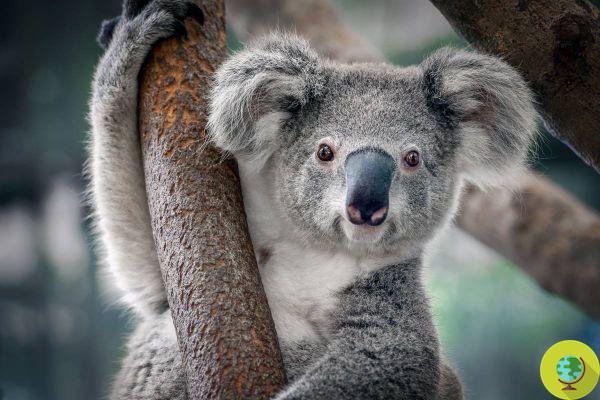
According to a new WFF report, human impact has accelerated "natural loss" and more endangered species.
He is about to end up run over, his mother saves himAccording to a new report, human impact has accelerated the "natural loss" of biodiversity
From the northern white rhino, declared extinct in 2018 with the last specimen in captivity and well before those in the wild due to poachers, to the Java tiger, which disappeared in '79, how many species have become extinct - in the last two centuries - due to of man? We are in the midst of sixth mass extinction, with a rate of extinction of animal and plant species 1.000 times higher than the natural one.
This is what emerges from the new WWF report "Extinctions: let's not send the planet in red", which highlights the data provided by the experts: the most important factor in the loss of biodiversity on terrestrial systems has been and still is the change in use of soils, starting from conversion of primary habitats, like the primeval forests, transformed into land for agricultural production.
Read also: Deforestation: so your consumption habits are causing the loss of 4 trees per year
The report
Between 1970 and 2016, 68% of the monitored populations of mammals, birds, amphibians, reptiles and fish experienced a steep decline. Not only land use change, but also excessive fishing in the oceans are the main causes, to which the impacts of climate change will be added more and more in the future with increasingly devastating phenomena, starting from fires.
Extinction then generates extinction since the loss of one species causes a "domino" effect that favors the disappearance of others - they say from WWF. The coronavirus pandemic has made us understand the many dangers associated with the destruction of natural habitats by man. Interfering and destroying the balance of natural ecosystems by plundering habitats causes new emergencies, not just health ones. The unstoppable increase in human population, the destruction of natural habitats, deforestation, the trafficking and trade of wildlife, intensive farming, pollution and the climate crisis are all interrelated problems.
And Valeria Barbi, naturalist political scientist Ambassador of EuCliPa Italy, explained it to us when, in view of Cop26, we also took stock of the great biodiversity crisis: of the 8.7 million estimated animal and plant species, about 1 million are at risk of extinction. Read the interview here: Each of us can become a “climate refugee”, but COP26 will try to reverse the course (INTERVIEW).
The IUCN has ascertained fact the extinction of at least 160 species in the last decade. This number, albeit high, probably represents an underestimate, both due to the difficulty of research and the lack of knowledge about some taxa, considered "minor" (primarily among invertebrates).
The causes and factors that lead species first to rarefaction and then to extinction in this dramatic historical moment are numerous and unfortunately there is the hand of man in all of them: starting from the industrial revolution, human activities have destroyed and degraded more and more forests, grasslands, wetlands and other important ecosystems, threatening human well-being. 75% of the earth's surface not covered by ice has already been significantly altered, most of the oceans are polluted and more than 85% of the wetland surface has been lost.
The animals that symbolize the planet's “red check”
The symbol of how the most remote and wild nature has been achieved by the effects of our unsustainability, starting with global climate change, is precisely thepolar bear (Ursus maritimus), whose habitat is compromised to the point that if the melting trends of the polar caps and the disappearance of an environment suitable for moving around and getting food continue as in the last decades, in just 35 years we risk losing up to 30% of the polar bear population.
Read also: The old polar bear in the zoo playing in the snow is one of the saddest things ever seen
Climate change affects nearly half (47%) of endangered land mammals, excluding bats, and a quarter (23%) of endangered birds may already have been adversely affected by climate change, at least some of their own. areal. Among the disastrous effects of climate change there is also the intensification of fires in various parts of the world: the fire runs fast through the forests and savannas and slower animals pay the price. This is the case with the koala (Phascolarctos cinereus) a symbol of Australian fauna, now in decline in eastern Australia.
Read also: Koala family finally returns home after devastating Australian fires
Another sign that is impacting our survival is the disappearance of pollinators, victims of pesticides and other poisons used in agriculture: butterflies, bees, bumblebees and other insects are essential for global food production. Almost 90% of the wild plants that bloom and over 75% of the main existing agricultural crops require animal pollination to reproduce. According to the IUCN, more than 40% of invertebrate pollinator species are in danger of disappearing. Almost half of the insect species in Europe are in serious decline. 37% of bee populations and 31% of butterfly populations show negative trends.
The hand of man goes to the extreme, carrying out real crimes of nature such as poaching: the victim symbol of this plague is the tiger (Panthera tigris), hunted to feed one of the most difficult phenomena to eradicate because it is very profitable, the illegal trade in animals or parts of them. And finally there are thesavanna elephant (Loxodonta africana) and theforest elephant (Loxodonta cyclotis), both species in 2021 were for the first time included in the highest risk categories of the IUCN red list, recalls the WWF, by launching the “At Christmas put your heart” campaign.
Follow us on Telegram | Instagram | Facebook | TikTok | Youtube
Source: WWF
Read also:
- At risk of extinction as many as 600 species of animals more than expected. I study
- Mass extinction risk for marine animals, due to intensive fishing (VIDEO)


























